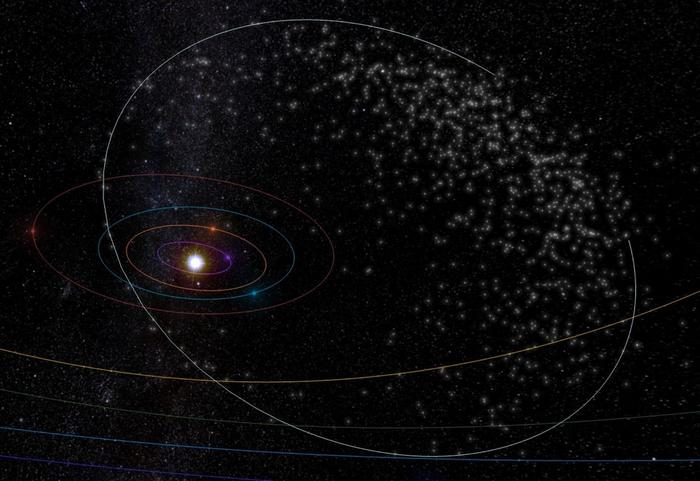Understanding the Dynamics of Long-Period Comets and Their Meteoroid Streams: A Revolutionary Perspective
In a groundbreaking study recently published in the journal Icarus, scientists from the SETI Institute have unveiled new insights into the complex movements of long-period comets and their associated meteoroid streams. The research specifically addresses the puzzling question of why these celestial bodies frequently weave in and out of Earth’s orbit, leading to the sporadic occurrence of meteor showers. Instead of attributing these dynamics solely to the gravitational influences of other planets within our solar system, the researchers contend that a significant factor lies with the movements of the Sun itself.
Lead author Stuart Pilorz, a researcher at the SETI Institute, explains a crucial misconception within the astronomical community regarding the orbits in our solar system. Traditionally, astronomers have envisioned the Sun as the fixed center around which all other celestial bodies revolve. However, Pilorz emphasizes that this perspective is misleading, as both planets and the Sun engage in a mutual orbit around their common center of mass—known as the solar system barycenter.
This barycenter is the balance point of our solar system, effectively a hidden fulcrum that dictates the dynamics of celestial movements. As such, the Sun too is in constant motion, adding an additional layer of complexity to the orbits of comets. Many of these long-period comets, which take more than 200 years to complete a single orbit around the Sun, spend the majority of their lives far from this barycenter, creating a unique scenario for their gravitational interactions.
As long-period comets journey closer to the Sun, they undergo a transformation. During this close approach, they begin to shed particles known as meteoroids, which follow their trajectories and may eventually create meteor showers upon their subsequent encounters with Earth. However, the orbits of these meteoroids are not uniform. As the comet approaches the Sun, differing gravitational interactions lead to various dispersions among the meteoroids, meaning some will return to Earth sooner, while others may take considerably longer, leading to a complex and evolving meteoroid stream.
In previous years, predicting when a shower of meteors would appear on Earth was akin to forecasting the weather—a daunting task filled with uncertainties. Notably, co-author Peter Jenniskens, whose distinctive background as a meteor astronomer with the SETI Institute and NASA Ames Research Center, highlighted the challenge of tracking these streams. The research team came together to reevaluate the motions of these meteoroid streams and decipher their enigmatic patterns in relation to the Sun’s motions.
Jenniskens recalls his early observations from 1995, when he first elucidated the connection between the streams and the intricate wobbles of the Sun caused by the massive gravitational pull of the planets, particularly Jupiter and Saturn. This wobble, though subtle, influences the path of the comets, causing them to drift in and out of Earth’s orbital path.
The study results reveal that although these cometary streams have a propensity to deviate, the wobbles in the Sun’s position significantly govern their behavior. The researchers employed advanced numerical models to demonstrate that meteoroid streams undergo gravitational boosts and braking when they encounter the Sun. These gravitational interactions effectively alter their trajectories, perpetuating the weaving motion seen in these celestial formations.
Pilorz’s ground-breaking conclusion suggests that the dispersion of meteor streams is more fundamentally linked to the movements of the Sun rather than being the result of random planetary gravitational perturbations. In effect, this reevaluation prompts a simpler understanding of the underlying physical processes that govern comet and meteoroid disintegration.
This new perspective invites a reformation in how researchers might interpret the dispersal patterns of these long-period comet streams. Instead of viewing the planets as the primary influencers of cometary orbits, Pilorz asserts that acknowledging the Sun’s motion can clarify many previously puzzling phenomena regarding meteor showers. As meteoroids navigate around the Sun at varying speeds, their encounters lead to distinct energetic shifts that manifest as deviations in their paths.
The implications of these findings extend beyond immediate observations of meteoroid showers. By harnessing a more robust model, researchers can calculate the age of hundreds of long-period comet meteor streams and enhance our understanding of their origins. These insights could enable astronomers to reconstruct the trajectories of comets and predict future meteor showers based on a better-established timeline.
As the investigation continues, it becomes increasingly evident that the relationship between the Sun and the celestial bodies that traverse its vicinity is far more intricate than previously established. This shifts our focus to an ongoing dance within our solar system, highlighting the interplay between the planets and their radiant source of energy. Understanding these nuances contributes significantly to our broader knowledge of both the history of our solar system and the unpredictable phenomena that continue to captivate observers on Earth.
The findings presented by the SETI Institute researchers have the potential to rekindle interest in the study of meteor showers. As scientists incorporate these insights into numerical models, there lies an exciting opportunity not only to predict when the next meteor shower will occur but also to revive the ancient connections between humans and the cosmos.
In summary, the research presented offers a revelatory view of the dynamics governing long-period comets and their meteoroid streams, illustrating how a reconsideration of the Sun’s role can reshape our understanding of celestial navigation in our solar system.
Subject of Research: The dynamics of long-period comets and their meteoroid streams
Article Title: Sun Close-Encounter model of long-period comet and Meteoroid Orbit Stochastic Evolution
News Publication Date: April 16, 2025
Web References: SETI Institute
References: Pilorz, S., & Jenniskens, P. (2025). Sun Close-Encounter model of long-period comet and Meteoroid Orbit Stochastic Evolution. Icarus.
Image Credits: Credit: meteorshowers.org
Keywords
Comets, Meteoroids, Solar System, Gravitational Dynamics, Meteor Showers, SETI Institute, Icarus, Astronomy, Astronomy Research, Long-Period Comets, Solar System Barycenter




